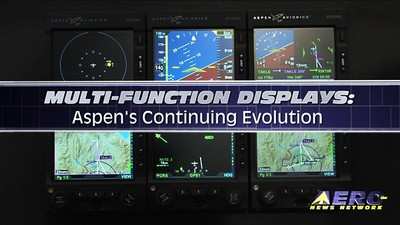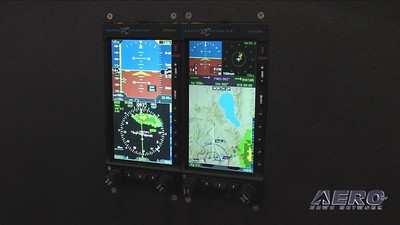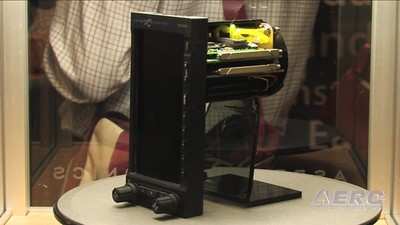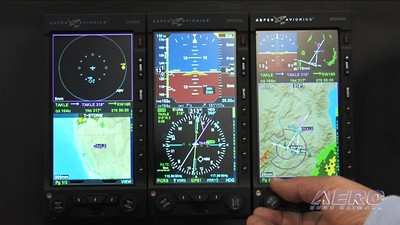Completing the vision... that's what Aspen's Doug Cayne was
telling Aero-TV about during the 2009 AEA Convention and Trade
Show. And the next step on the road to Aspen's revolutionary aims
is to get the EFD 1000 (and its little cousin, the EFD500) out on
the market.

The EFD1000 MFD is designed to enhance the choice of Evolution
primary flight display, adding moving maps, datalink weather and
traffic interfaces, a built-in terrain awareness database, flight
information pages and more. Built using the same hardware as their
PFD, this EFD1000 MFD offers a full duplicate set of ADAHRS
sensors, works with the PFD to continually monitor its health, and
can automatically become a backup PFD if the primary should
deteriorate or fail.

The EFD500 MFD provides the same great MFD features as the
EFD1000 MFD at a lower price, by eliminating the ADAHRS sensor set
(and the ability to serve as a PFD backup). It is also ideal as a
third tube to round out a glass cockpit six-pack replacement, and
can be installed as a slave display to the EFD1000 MFD to make
installation a snap.

Flush Mount Solution
A Flush Mount Kit will enable customers to mount Evolution
Flight Displays (EFDs) flush with their instrument panels. While
many customers prefer the lower cost and easier installation of the
EFD’s standard surface mounting, others have wanted to mount
the EFD from behind the panel. The flush mounting system is
expandable, and is available in 1-, 2- and 3-tube versions.
The Flush Mount Kits will be available as options from June 15th
of this year, starting at $390 MSRP for a single-tube PFD
installation.
Expanded Support for Additional Analog Interfaces
A new Analog Converter Unit (ACU) will add expanded capabilities
frequently requested by Aspen customers. The ACU is used by the EFD
system to integrate legacy analog systems, such as autopilots and
VHF radios, with the all-digital Evolution system. The new ACU will
be available in several configurations, depending on the
customer’s needs.

The first version will add analog XYZ heading synchro outputs to
support legacy traffic, weather, and other systems requiring analog
heading inputs.
The new ACU will be available by the end of 2009 at a list price
under $2,000. Another version, expected in 1Q2010, will add support
for dual analog ADF and DME receivers, capabilities in higher
demand from Aspen’s international customers, and from US
customers operating Class III airplanes.
Autopilot Attitude Reference Source Replacement
The upgrade perhaps most requested by customers is a means to
completely eliminate all mechanical flight instruments. Pilots
accustomed to flying glass cockpits increasingly want their backup
instruments to look like their primary EFIS, making them easier to
fly in an emergency, instead of having to revert to an old-style
“steam gauge” instrument scan. Moreover, the avionics
industry is struggling with shortages of parts and people skills to
overhaul these obsolescent mechanical instruments, driving up
overhaul costs.

A multi-tube, dual AHRS EFD1000 system is designed to eliminate
the need to keep mechanical backup instruments in the pilot’s
primary field of view. But since most GA autopilots still depend on
a mechanical gyro for their attitude reference source, until the
electronic AHRS can serve as that reference the mechanical gyro
must remain in the airplane. To date, no GA glass cockpit AHRS has
been certified to serve as the attitude reference source for legacy
analog GA autopilots.
Aspen is developing an optional upgrade to enable the EFD1000
AHRS to serve as the autopilot attitude reference source, and to
replace the mechanical gyros driving popular GA autopilot
systems.
 ANN's Daily Aero-Linx (04.30.25)
ANN's Daily Aero-Linx (04.30.25) ANN FAQ: Turn On Post Notifications
ANN FAQ: Turn On Post Notifications Classic Aero-TV: Agile Aeros Jeff Greason--Disruptive Aerospace Innovations
Classic Aero-TV: Agile Aeros Jeff Greason--Disruptive Aerospace Innovations Aero-News: Quote of the Day (04.30.25)
Aero-News: Quote of the Day (04.30.25) ANN's Daily Aero-Term (04.30.25): Expedite
ANN's Daily Aero-Term (04.30.25): Expedite







